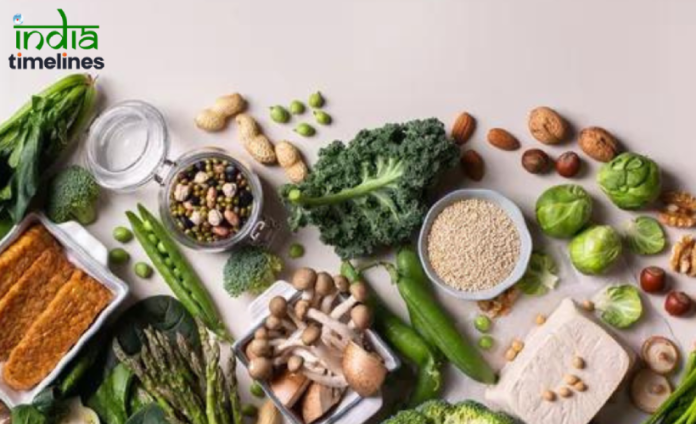
In the realm of healthy eating, protein often takes center stage, and for good reason. It’s a vital macronutrient that supports muscle growth, repairs tissues, and keeps us feeling full and satisfied. While many people associate protein mainly with meat and dairy, vegetables can also be excellent sources of this essential nutrient. In this blog, we’ll explore a variety of high-protein vegetables that you can easily incorporate into your meals to boost your protein intake and enhance your overall nutrition.
Peas
Peas are small yet mighty nutritional powerhouses, packing nearly 8 grams of protein in just one cup. According to Sassos, they serve as an excellent plant-based protein base for various dishes, with options like pea-based pastas and rice. Additionally, many vegan protein powders are derived from peas. Beyond protein, peas offer antioxidants such as vitamin C, fiber, and some iron.
Spinach
Cooking spinach can maximize its nutritional benefits. Taub-Dix notes that one cup of cooked spinach provides a substantial 5 grams of protein, as cooking reduces its volume while concentrating its protein content. Spinach is also rich in iron, calcium, and vitamins A, C, and K. Whether added to breakfast dishes like eggs or smoothies, incorporated into salads or grain bowls for lunch, or used in dinner recipes such as pasta, soups, stews, or curries, spinach adds a nutritious boost.
Sweet Potato
With about 4 grams of protein per cup when cooked, sweet potatoes are a nutritional powerhouse. Werner highlights their existing benefits, including being rich in potassium, vitamins B6 and C, and fiber, which aids in blood sugar regulation and may help manage cholesterol levels. Sweet potatoes are versatile and can be incorporated into various dishes to enhance their nutritional value.
Mushrooms
Cooked mushrooms offer around 3 grams of protein per cup, making them a tasty addition to your daily protein intake. In addition to protein, mushrooms provide essential nutrients like selenium, B-vitamins, and potassium. Taub-Dix suggests using mushrooms as a versatile ingredient to enhance the nutritional profile of dishes, such as adding them to ground meat, turkey, or tofu for added plant-based nutrition and flavor.
Corn
Although often overlooked due to its classification as a starchy vegetable, corn packs a surprising 5 grams of protein per cup when cooked, notes Taub-Dix. In addition to adding a vibrant yellow hue to dishes, corn provides essential fiber, which is lacking in many diets, along with B vitamins. Whether enjoyed on its own or incorporated into dishes like polenta, cornmeal pancakes, or alongside beans, corn offers both flavor and nutrition.
Beans
Beans are incredibly versatile, fitting into multiple food groups with ease, explains Taub-Dix. These plant-based staples serve as protein sources, carbohydrates, and vegetables all at once. Depending on the variety, beans offer varying protein contents, with standouts like black beans (15 grams per cup), chickpeas (14.5 grams per cup), kidney beans (13 grams per cup), and lentils (18 grams per cup). Whether canned for convenience or cooked from dried beans, they provide a convenient and nutritious addition to meals. Roasted beans also make for a crunchy and protein-rich snack.
Broccoli
Raw broccoli contributes around 3 grams of protein per cup, but cooking can increase its protein content per serving. Broccoli’s versatility allows for creative culinary exploration, whether stir-fried, roasted as a side dish, or incorporated into omelets. It can also be finely chopped and mixed with grains like rice for added nutrition.
Artichoke
Artichokes offer approximately 5 grams of protein per cup when cooked, in addition to being rich in fiber. Whether enjoyed roasted, added to salads, or stirred into pasta dishes, these springtime vegetables provide both flavor and nutritional benefits.
Brussels Sprouts
Cooked Brussels sprouts provide about 4 grams of protein per cup, along with plenty of fiber, vitamin C, and vitamin K, according to Taub-Dix. While roasting or air-frying is a popular cooking method, Brussels sprouts can also be enjoyed by peeling off individual leaves or finely shredding them for use in salads, slaws, or wraps.
Edamame
Edamame stands out as a unique plant-based protein source because it contains all nine essential amino acids, making it a complete protein. Werner notes that shelled edamame, readily available in the frozen section, provides approximately 12 grams of protein per 100 grams. Conveniently de-podded, it can be easily added to salads, grain bowls, or mixed with other vegetables for an additional protein boost.































